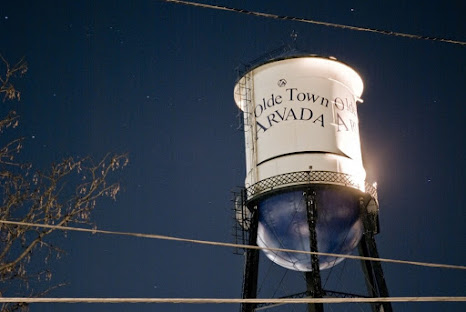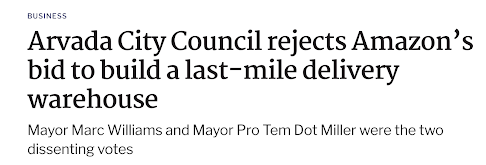 |
| Arvada is an historic, independent city in the western suburbs of Denver - photo Creative Commons |
by Gregory Saville
Amazon is a global, corporate superstar. Arvada is a suburban city 15 miles from downtown Denver, with 120,000 people spread in dozens of residential neighborhoods. The annual Arvada budget is $250 million compared to Amazon’s $1.6 trillion. It's David and Goliath.
So you might wonder how Arvada could resist when Amazon showed up with a plan to build a 112,000 square foot distribution center - a delivery hub - onto a 36-acre undeveloped site. Amazon came with an offer of 2,000 jobs, tax revenues, and a green buffer to shield nearby housing.
Yesterday Arvada council rejected the proposal.
Triggered by a local citizen anti-development campaign, and a petition of 10,000 residents who opposed the plan, City Council voted 5-2 to reject the Amazon proposal. Why? And what does this have to do with neighborhood crime?
WHY?
Did the residents oppose Amazon’s taxation history (e.g.: media stories that they don’t pay enough)? Nope, that was not a main point of contention. Were there complaints about Amazon’s global environmental record? Nope. In fact, Amazon co-founded the Climate Pledge and Global Optimism program aiming for net-zero carbon in the next 20 years, ordered 100,000 electric delivery vehicles, and spent $100 million into the Right Now Climate fund to focus on solutions to climate warming. Wow! That should impress even the naysayers.
Not so in Arvada.
 |
| Local news coverage of the controversial Arvada vote |
One environmental group complained that the development would destroy a nearby active wildlife habitat. But it was traffic congestion that carried the day, namely, complaints about hundreds of delivery vehicles and a 1,000 vehicle parking lot.
In a car-dependent suburb, where walking takes second place to driving, vehicle congestion is the thing. It obviously was on the minds of the 5 councillors who voted it down. I’m sure 10,000 opposing petition signatures caught their attention.
HOW IS THIS CRIME RELATED?
The vote, of course, might have gone the other way. Amazon made a strong case and everyone loves to get stuff delivered promptly by Amazon – especially during this pandemic. Add to that two thousand jobs - not an insignificant number!
But traffic jams and growing congestion is a powerful motivator in the face of a weak bus system and a new, but grossly underutilized, commuter rail line to downtown Denver. In American suburbs, cars rule!
 |
| Site rendering of the Amazon proposal from the Project Indiana website |
The takeaway? When it comes to changing future cities for the better, it is crucial that we understand the politics, dynamics, and economics of land acquisition and usage. All the slick 3-D renderings, public statements, comprehensive plans, zoning regulations, and design guidelines, (such as CPTED design guidelines), do not matter one iota if resident expectations are unfulfilled.
Nor does it matter to complain about racism, gentrification, or the “flat white urbanism” planning bias if new developments flail and falter at the altar of public expectations. (Not that any of those things were part of this story).
A REALISTIC WAY FORWARD
If we want to bring forth a new form of neighborhood safety planning (and in SafeGrowth, we do), we need to dive deeply into the mindset of local residents. We need to avoid NIMBY name-calling and figure how to work alongside residents from the get-go.
In SafeGrowth we use co-planning workshops, Livability Academies, and other types of intense neighborhood engagement. This must happen long before development proposals are written up in some distant office.
I’m unsure if a more exciting and beneficial outcome might have emerged from a more collaborative planning process. I suspect the answer is yes. This week in Arvada, the answer was no! David slew Goliath.
Leave a comment
Please add comments to SafeGrowth. I will post everyone except posts with abusive, off-topic, or offensive language; any discriminatory, racist, sexist or homophopic slurs; thread spamming; or ad hominem attacks.
If your comment does not appear in a day due to blogspot problems send it to safegrowth.office@gmail.com and we'll post direct.